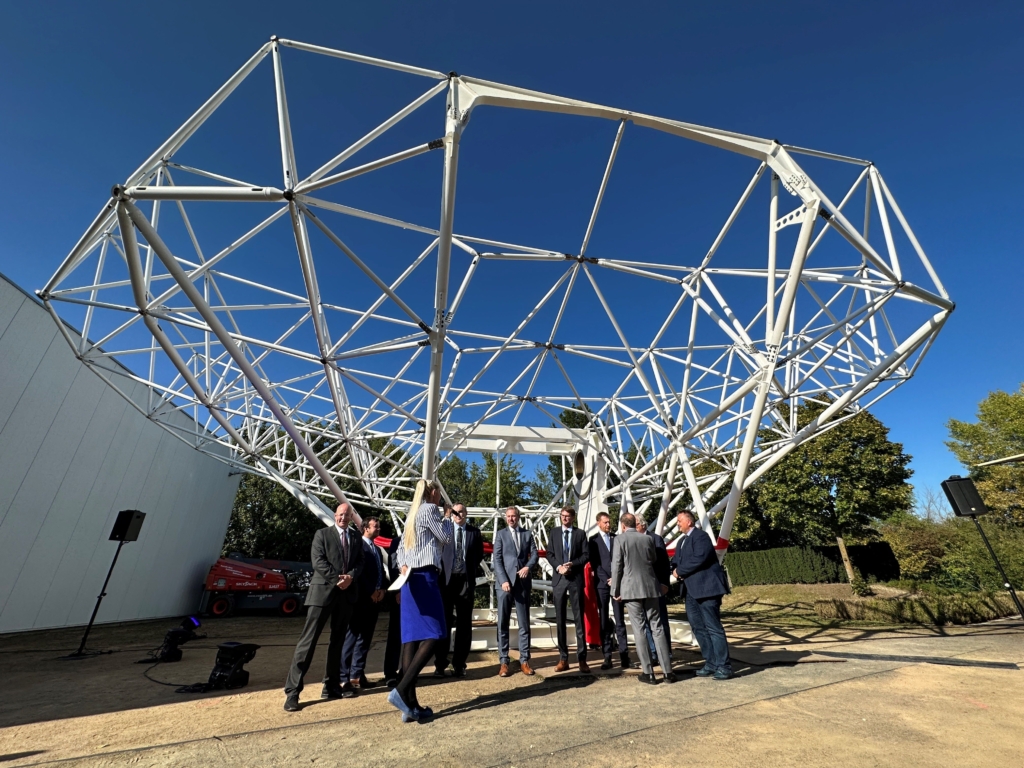Researchers from the U.S. National Science Foundation National Radio Astronomy Observatory (NSF NRAO), in collaboration with SpaceX, have introduced the Operational Data Sharing (ODS) system, a self-reporting framework designed to foster coexistence between radio telescopes and non-geostationary orbit (NGSO) satellite constellations, such as SpaceX’s Starlink.
Recent News
NSF VLBA Peers Into the “Eye of Sauron” to Solve Cosmic Neutrino Mystery
Findings, published in Astronomy & Astrophysics Letters, reveal that the blazar PKS 1424+240 – dubbed the “Eye of Sauron” for its striking appearance – points its powerful jet almost directly at Earth, creating an extreme cosmic lighthouse effect.
Astronomers Catch Supermassive Black Hole in the Act of ‘Waking Up’
This discovery offers new insights into how these cosmic giants begin to influence their environments and could help solve longstanding puzzles about galaxy evolution.
German tech factory reveals antenna prototype—ngVLA will open a new window into the Universe

Usually it’s Octoberfest that draws a crowd to Germany this time of year. For hundreds of folks gathered at mtex antenna technology in Schkeuditz, it’s a first look at a prototype radio telescope that may one day be part one of the world’s largest and most sensitive radio telescopes in the world, the National Radio Astronomy Observatory’s (NRAO) next generation Very Large Array (ngVLA). The prototype antenna was unveiled to an excited crowd of government and business leaders, scientists, engineers, and the press from Germany and US.
The prototype antenna’s 18-meter dish, just under the height of a six-story building, is composed of 76 individual aluminum panels assembled in a striking 8-sided shape. “This design allows the surface of the dish to withstand whatever the environment throws at it—extreme temperature, wind, gravity—the reflector will maintain its precise shape within several microns, the equivalent of three human hairs,” explained Lutz Stenvers, managing director of mtex antenna technology. “The structure has 724 pieces, held together with 2,500 screws, weighing in at 43 tons. This design can be shipped in multiple containers to anywhere in the world, and assembled in very little time.”
Time and distance are important factors in ngVLA’s development. A total of 244 dishes are planned for the massive instrument, with a core array of telescopes working together throughout New Mexico and the American southwest, along with a longer baseline across the US, Mexico and Canada.
The ngVLA has received funding for design and project review from the National Science Foundation (NSF), who supports the majority of NRAO’s operations, with oversight from Associated Universities, Inc. (AUI.)
This preview of the antenna was the closing event for scientists and AUI, NRAO, and NSF staff attending a workshop exploring research opportunities for the ngVLA held at Max Planck Institute for Mathematics in the Sciences in Leipzig.
mtex has been awarded a $1 million state grant from the New Mexico Local Economic Development Act (LEDA) job-creation fund to assist with land, building, and infrastructure costs for their new Albuquerque facility. The City has pledged an additional $300,000 from its municipal LEDA funds.
NRAO’s partnerships with New Mexico Tech and the University of New Mexico are crucial to the ngVLA’s future. NRAO recently signed a new memo of understanding with the University of New Mexico to explore data housing, internships and training for astronomy, engineering, and other fields of STEM education.
The National Radio Astronomy Observatory is a facility of the National Science Foundation, operated under a cooperative agreement by Associated Universities, Inc.
This news article was originally published on NRAO website on September 28, 2023.
Recent News
Satellite Internet Meets Space Science: A Groundbreaking Solution for Spectrum Sharing
Researchers from the U.S. National Science Foundation National Radio Astronomy Observatory (NSF NRAO), in collaboration with SpaceX, have introduced the Operational Data Sharing (ODS) system, a self-reporting framework designed to foster coexistence between radio telescopes and non-geostationary orbit (NGSO) satellite constellations, such as SpaceX’s Starlink.
NSF VLBA Peers Into the “Eye of Sauron” to Solve Cosmic Neutrino Mystery
Findings, published in Astronomy & Astrophysics Letters, reveal that the blazar PKS 1424+240 – dubbed the “Eye of Sauron” for its striking appearance – points its powerful jet almost directly at Earth, creating an extreme cosmic lighthouse effect.
Astronomers Catch Supermassive Black Hole in the Act of ‘Waking Up’
This discovery offers new insights into how these cosmic giants begin to influence their environments and could help solve longstanding puzzles about galaxy evolution.
